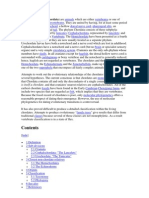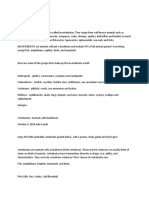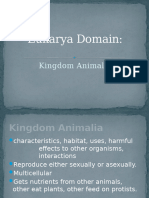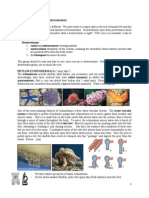0 ratings0% found this document useful (0 votes)
4 viewsScience 4 Kian
Science 4 Kian
Uploaded by
EDITHA CASILANTerrestrial animals first evolved in the Carboniferous period and include reptiles, which were the first true land animals. Terrestrial animals spend most or all of their life on land unlike amphibians. Examples include mammals like lions, cats, dogs as well as insects and arachnids.
Copyright:
© All Rights Reserved
Available Formats
Download as DOCX, PDF, TXT or read online from Scribd
Science 4 Kian
Science 4 Kian
Uploaded by
EDITHA CASILAN0 ratings0% found this document useful (0 votes)
4 views21 pagesTerrestrial animals first evolved in the Carboniferous period and include reptiles, which were the first true land animals. Terrestrial animals spend most or all of their life on land unlike amphibians. Examples include mammals like lions, cats, dogs as well as insects and arachnids.
Original Title
science 4 kian
Copyright
© © All Rights Reserved
Available Formats
DOCX, PDF, TXT or read online from Scribd
Share this document
Did you find this document useful?
Is this content inappropriate?
Terrestrial animals first evolved in the Carboniferous period and include reptiles, which were the first true land animals. Terrestrial animals spend most or all of their life on land unlike amphibians. Examples include mammals like lions, cats, dogs as well as insects and arachnids.
Copyright:
© All Rights Reserved
Available Formats
Download as DOCX, PDF, TXT or read online from Scribd
Download as docx, pdf, or txt
0 ratings0% found this document useful (0 votes)
4 views21 pagesScience 4 Kian
Science 4 Kian
Uploaded by
EDITHA CASILANTerrestrial animals first evolved in the Carboniferous period and include reptiles, which were the first true land animals. Terrestrial animals spend most or all of their life on land unlike amphibians. Examples include mammals like lions, cats, dogs as well as insects and arachnids.
Copyright:
© All Rights Reserved
Available Formats
Download as DOCX, PDF, TXT or read online from Scribd
Download as docx, pdf, or txt
You are on page 1of 21
Arthropods were the first animals to take the first steps on
land along with myriapods (“centipedes”) and arachnids
(spiders, scorpions, mites) at the end of the Silurian, 430
million years ago, then hexapods (insects) followed at the
beginning of the Devonian (- 410 million years).
Reptiles evolved in the Carboniferous period during the
Paleozoic Era. They were the first true land animals, as
amphibians, echinoderms, and insects have also evolved
before them, but they do not live entirely on land.
Therefore, reptiles are the first truly terrestrial animals.
The lion is a wild terrestrial animal
called the king of the forest. The
lion is a strong animal with a
strong body, a big head, a
majestic mane, and two fierce
eyes. Lions are predatory animals
and eat only after hunting. They
have strong claws and sharp
teeth, which help them hunt their
prey and eat the flesh.
Terrestrial animals are animals
that live predominantly or entirely
on land (e.g. cats, chickens, ants,
spiders), as compared with
aquatic animals, which live
predominantly or entirely in the
water (e.g. fish, lobsters,
octopuses), and amphibians,
which rely on aquatic and
terrestrial habitats (e.g. frogs and
newts).
Terrestrial animals spend most of or their entire life span on
land, in contrast to animals that live predominantly in water.
Examples of terrestrial animals include cats, ants, dogs,
raccoons, spiders, kangaroos, tigers, lions, mice, bats, bulls,
oxen, leopards, elephants, and many more.
Dolphins have
smooth, rubbery skin
and are usually
colored in some
mixture of black,
white, and gray. They
have two flippers, or
fins, on their sides, as well as a triangular fin on
the back. Like other whales, they have an
insulating layer of blubber (fat) beneath the skin.
Whales resemble fish
because of their fins and
hydrodynamic bodies,
but have far more in
common anatomically
with other mammals.
Somedistinct physical
characteristics include:
Baleen: Also known as
whalebone, baleen is a
filter-feeder system
inside the mouths of whales in the Mysticeti suborder.
Fish are aquatic
vertebrate animals
that have gills but
lack limbs with digits,
like fingers or toes.
Recall that
vertebrates are
animals with internal
backbones. Most fish are streamlined in their
general body form.
Molluscs have a mantle
or mass of soft flesh
that covers the soft
body and encloses the
internal organs. In
many species, the
mantle produces a hard
shell. Not all molluscs produce a shell. Many
molluscs have a radula, which, in most species, is a
rasp-like scraping organ used in feeding .
The octopus is a marine mollusk
and a member of the class
Cephalopoda, more commonly
called cephalopods.
Cephalopoda means “head
foot” in Greek, and in this class
of organisms, the head and feet
are merged. A ring of eight
equally-long arms surround the head. They use
their arms to "walk" on seafloor.
Cuttlefish are a chunky
squid-like creature with
a well-developed head,
large eyes and mouths
with beak-like jaws. They
have a fin that runs
around their body, eight 'arms' with suckers plus
two tentacles around the mouth. Cuttlefish are
extremely variable in colour, but are usually
blackish-brown, mottled or striped.
Jellyfish have no brain, heart,
bones or eyes. They are made
up of a smooth, bag-like body
and tentacles armed with
tiny, stinging cells. These
incredible invertebrates use
their stinging tentacles to stun
or paralyse prey before gobbling it up. The
jellyfish's mouth is found in the centre of its body.
Most starfish sport
spiny skin and five
arms surrounding a
central disk-shape
body – although some
can grow as many as
50 arms. Their arms are covered with pincer-like
organs and suckers that allow the animal to slowly
creep along the ocean floor.
A squid ( pl. : squid) is a
mollusc with an elongated
soft body, large eyes, eight
arms, and two tentacles in
the superorder
Decapodiformes, though
many other molluscs within
the broader Neocoleoidea are also called squid
despite not strictly fitting these criteria.
A crab is a sea creature with a flat round body
covered by a shell, and five pairs of legs with large
claws on the front pair. Crabs usually move
sideways. Crab is the flesh of this creature eaten as
food.
Seal, any of 32 species of
web-footed aquatic
mammals that live chiefly
in cold seas and whose
body shape, round at the
middle and tapered at
the ends, is adapted to
swift and graceful swimming.
Crocodiles have powerful jaws with many conical
teeth and short legs with clawed webbed toes.
They share a unique body form that allows the
eyes, ears, and nostrils to be above the water
surface while
most of the
animal is hidden
below. The tail is
long and massive,
and the skin is
thick and plated.
A snail is a small mollusk with a spiral-shaped shell.
Snails are famous for moving very slowly, and for
leaving a trail of slime behind them. If you see
snails on a restaurant menu, they're more likely to
be listed as escargot, or "edible snail" in French.
In general, frogs have protruding eyes, no tail, and
strong, webbed hind feet that are adapted for
leaping and swimming. They also possess smooth,
moist skins. Many are predominantly aquatic, but
some live on land, in burrows, or in trees.
TERRESTRIAL
ANIMALS
AQUATIC
ANIMALS
You might also like
- Closer de Patrick Marber (Text)Document60 pagesCloser de Patrick Marber (Text)Edgar Bunea100% (1)
- Oxford Phonics World 1.sightwwords 1Document28 pagesOxford Phonics World 1.sightwwords 1Johnny Frey Culanculan75% (4)
- VertebratesDocument8 pagesVertebratesfeya ayefNo ratings yet
- BTM 111 22Document24 pagesBTM 111 22Toke SadockNo ratings yet
- Mammals That Have Wings and Can FlyDocument3 pagesMammals That Have Wings and Can FlyrapaseNo ratings yet
- Project ScienceDocument16 pagesProject Scienceangelica nicole san juanNo ratings yet
- Project IN Science: Submitted By: Rovie Mark Y. Lopez Grade 6-Juan Luna Submitted To: Mr. Bernardino N. LibaoDocument34 pagesProject IN Science: Submitted By: Rovie Mark Y. Lopez Grade 6-Juan Luna Submitted To: Mr. Bernardino N. LibaoAlexanderLopezNebresNo ratings yet
- Animals That Lived On WaterDocument9 pagesAnimals That Lived On WaterCasey PedrayaNo ratings yet
- AnimalsDocument43 pagesAnimalsGina ZanneNo ratings yet
- UnderwaterDocument6 pagesUnderwaterAni putri syarifahNo ratings yet
- 60c9a75022f9c20210616072504general Charecter and Clasification of PiscesDocument4 pages60c9a75022f9c20210616072504general Charecter and Clasification of PiscesAijaz AhmadNo ratings yet
- invertibraeDocument10 pagesinvertibraemknightNo ratings yet
- Genbio 11 20Document2 pagesGenbio 11 20sophtzu9No ratings yet
- Invertebrate DefinitionDocument8 pagesInvertebrate Definitionashley brownNo ratings yet
- From Wikipedia, The Free Encyclopedia Jump To:, For Other Uses, SeeDocument5 pagesFrom Wikipedia, The Free Encyclopedia Jump To:, For Other Uses, SeefrndgurlNo ratings yet
- Vertebrates (Kingdom Animalia)Document130 pagesVertebrates (Kingdom Animalia)Nurl AinaNo ratings yet
- Science 2nd Summative TestDocument20 pagesScience 2nd Summative Testmary alyssa dayaoNo ratings yet
- 1 - External Anatomy and TaxonomyDocument8 pages1 - External Anatomy and TaxonomyJuan David Quintero MonsalveNo ratings yet
- Zoology Assignment Part 2Document22 pagesZoology Assignment Part 2kvanaswara81No ratings yet
- Kingdom Classification 2Document6 pagesKingdom Classification 2frozenkiara22No ratings yet
- Anatomyoffinfish 180717204712Document36 pagesAnatomyoffinfish 180717204712usriuwi277No ratings yet
- EnglishDocument27 pagesEnglishkhairani100% (1)
- 14 BIOL 1201-MollusksDocument22 pages14 BIOL 1201-Molluskslikaswecelestine9No ratings yet
- Notes in English of BiologyDocument3 pagesNotes in English of Biologylau fjNo ratings yet
- PiscesDocument53 pagesPisceskudeepanshuku144No ratings yet
- Unit 5. InvertebratesDocument8 pagesUnit 5. InvertebratesYolanda Fernández VelascoNo ratings yet
- ChordataDocument41 pagesChordataHasna NanaNo ratings yet
- ChordatesDocument11 pagesChordatesMarcelle MedeirosNo ratings yet
- Reptiles: History: Reptiles Originated Approximately 300 Million Years Ago During The CarboniferousDocument32 pagesReptiles: History: Reptiles Originated Approximately 300 Million Years Ago During The CarboniferousCreate VinayNo ratings yet
- MollusksDocument40 pagesMollusksAlyssa LingamenNo ratings yet
- Outer Stratified EpidermisDocument8 pagesOuter Stratified EpidermisAsma AslamNo ratings yet
- First Semester 2020/2021Document52 pagesFirst Semester 2020/2021low luffecussNo ratings yet
- Phylum Chordata & Vert IntroDocument22 pagesPhylum Chordata & Vert IntroFarman khanNo ratings yet
- SummaryDocument1 pageSummarygadiconstanceNo ratings yet
- Do (See Microscope Slide Under Dissecting Scope) - The Larvae Are Called Tadpoles' and They Have A MouthDocument7 pagesDo (See Microscope Slide Under Dissecting Scope) - The Larvae Are Called Tadpoles' and They Have A MouthChie CenonNo ratings yet
- FISM 314 (1)Document5 pagesFISM 314 (1)beingemjayNo ratings yet
- Phylum ChordataDocument25 pagesPhylum ChordataNicole100% (1)
- 2 VertebratesDocument71 pages2 VertebratesJojo AcuñaNo ratings yet
- Jawless FishDocument6 pagesJawless FishmuhammadNo ratings yet
- Science Is Awesome!: 101 Incredible Things Every Kid Should KnowFrom EverandScience Is Awesome!: 101 Incredible Things Every Kid Should KnowNo ratings yet
- Animal ClassificationsvertebratesandinverDocument27 pagesAnimal ClassificationsvertebratesandinverSana Ishtiaq100% (1)
- Lecture 1: SHARKS: Corresponding Reading Material Shark Section in Lab Manual Levinton: Chapter 8Document15 pagesLecture 1: SHARKS: Corresponding Reading Material Shark Section in Lab Manual Levinton: Chapter 8JelenaNo ratings yet
- 124 Lec Chordate ReviewDocument9 pages124 Lec Chordate Reviewinder604cheemaNo ratings yet
- Phylum Mollusca: "Soft-Bodied Invertebrate Animal, Usually With An External Shell"Document18 pagesPhylum Mollusca: "Soft-Bodied Invertebrate Animal, Usually With An External Shell"Jofren MorenoNo ratings yet
- How Can We Classify AnimalsDocument5 pagesHow Can We Classify AnimalsNgoc HongNo ratings yet
- Molluscs Crustaceans & Cephalopods Species OnlyDocument20 pagesMolluscs Crustaceans & Cephalopods Species OnlyMarc VezinaNo ratings yet
- Chapter 18Document10 pagesChapter 18Aeriel Venice VergaraNo ratings yet
- Reporters: Maun, Maja Mariella Gonzales, Alessy Joy Cortez, KateDocument34 pagesReporters: Maun, Maja Mariella Gonzales, Alessy Joy Cortez, KateKate CortezNo ratings yet
- INVERTEBRATE AND VertebratesDocument3 pagesINVERTEBRATE AND Vertebratesian rex desolocNo ratings yet
- Musta'in, THPi Semester 2, Bahasa InggrisDocument3 pagesMusta'in, THPi Semester 2, Bahasa InggrisSiskaNo ratings yet
- Invertebrates Chordata VertebratesDocument62 pagesInvertebrates Chordata VertebratesDao Ming SiNo ratings yet
- Aquatic ResourcesDocument12 pagesAquatic ResourcesLexter PapauranNo ratings yet
- Turtles Tuataras Lizards Snakes Crocodiles Tetrapods: ReptilesDocument1 pageTurtles Tuataras Lizards Snakes Crocodiles Tetrapods: ReptilesAji Nikka AngelesNo ratings yet
- Zool 437 Notes 2024Document10 pagesZool 437 Notes 2024goodmanjames405No ratings yet
- Class 12th practical Aquatic Animals StudyDocument4 pagesClass 12th practical Aquatic Animals Studysynis1jakyk2No ratings yet
- AnimaliaDocument46 pagesAnimaliaChristine FidelNo ratings yet
- SZL102 Topic Five Class Osteichthyes-1Document5 pagesSZL102 Topic Five Class Osteichthyes-1jenkionyangoNo ratings yet
- UNIT-25 (Taxonomy Invertebrates and Vertebrates)Document25 pagesUNIT-25 (Taxonomy Invertebrates and Vertebrates)c r e a m p i eNo ratings yet
- ChondrichthyesDocument18 pagesChondrichthyesmey_maya51No ratings yet
- Class OsteichthyesDocument13 pagesClass Osteichthyesedivisha100% (1)
- Lab 13 Animals 2 (Deuterostomes)Document25 pagesLab 13 Animals 2 (Deuterostomes)13ucciNo ratings yet
- Certification-Schoolct 2Document1 pageCertification-Schoolct 2EDITHA CASILANNo ratings yet
- ACR - FormDocument4 pagesACR - FormEDITHA CASILANNo ratings yet
- Bow - Mathematics 3Document7 pagesBow - Mathematics 3EDITHA CASILANNo ratings yet
- Acr English MonthDocument13 pagesAcr English MonthEDITHA CASILANNo ratings yet
- Communication Plan For f2fDocument9 pagesCommunication Plan For f2fEDITHA CASILANNo ratings yet
- Attendance Record: Department of EducationDocument2 pagesAttendance Record: Department of EducationEDITHA CASILANNo ratings yet
- Contextualized Lesson Plan in Mathematics 4Document4 pagesContextualized Lesson Plan in Mathematics 4EDITHA CASILANNo ratings yet
- 50 Câu Trắc Nghiệm Collocation Tiếng Anh Ôn Thi THPT Quốc Gia 2022 Có Đáp ÁnDocument7 pages50 Câu Trắc Nghiệm Collocation Tiếng Anh Ôn Thi THPT Quốc Gia 2022 Có Đáp ÁnLan Như VõNo ratings yet
- Subject Verb AgreementDocument3 pagesSubject Verb AgreementCatherine MetraNo ratings yet
- Focus3 2E Grammar Quiz Unit5 5 GroupBDocument1 pageFocus3 2E Grammar Quiz Unit5 5 GroupBВиктор НовицкийNo ratings yet
- Dolphins - Earth's Most Intelligent Animals: Project Realized by Manea Alexandra Teacher - Tulei AngelaDocument11 pagesDolphins - Earth's Most Intelligent Animals: Project Realized by Manea Alexandra Teacher - Tulei AngelaManea AlexandraNo ratings yet
- Best Job in The WorldDocument2 pagesBest Job in The WorldLau VidelaNo ratings yet
- (Animal) Dan Wylie - Elephant-Reaktion Books (2009)Document207 pages(Animal) Dan Wylie - Elephant-Reaktion Books (2009)δημητρα χουχουληNo ratings yet
- Animales ListaDocument6 pagesAnimales ListaRsj Judith Ch-mNo ratings yet
- Cover Slide:: (Feel Free To Add Any of Your Own Facts Here As Well!) TipDocument3 pagesCover Slide:: (Feel Free To Add Any of Your Own Facts Here As Well!) Tiplisa grinbergNo ratings yet
- The Old Man and The Sea Section 6Document17 pagesThe Old Man and The Sea Section 6athulbyju2003No ratings yet
- Chaos of DeponiaDocument11 pagesChaos of DeponiaDamianSpagnulNo ratings yet
- Extension Grammar Unit6 Without Answers FeitoDocument1 pageExtension Grammar Unit6 Without Answers FeitoMariaBulhaoNo ratings yet
- Illest Road Trip Project Template (For Students) (LM)Document14 pagesIllest Road Trip Project Template (For Students) (LM)AnonymousNo ratings yet
- Course Test Unit 5 MoversDocument4 pagesCourse Test Unit 5 MoversMario Izquierdo JiménezNo ratings yet
- What Is My Spirit Animal Ebook 091715 2 PDFDocument23 pagesWhat Is My Spirit Animal Ebook 091715 2 PDFIose Creto67% (3)
- Palawan Peacock PheasantDocument2 pagesPalawan Peacock PheasantCarl Justine A. OfiazaNo ratings yet
- Session 1 Introduction To The Quglieys WildlifeDocument14 pagesSession 1 Introduction To The Quglieys WildlifeZahrah Z100% (1)
- Review For The First Semester Grade 5 2021 - 2022 Phan Chu Trinh Primary SchoolDocument5 pagesReview For The First Semester Grade 5 2021 - 2022 Phan Chu Trinh Primary SchoolVN LenaNo ratings yet
- Bulk Food: Peter Watts & Laurie ChannerDocument23 pagesBulk Food: Peter Watts & Laurie ChannerYesNo ratings yet
- Grade 6 1st TermDocument34 pagesGrade 6 1st TermAhmed AshrafNo ratings yet
- q2 w5 Lesson 2 Prepare and Cook Seafood DishesDocument23 pagesq2 w5 Lesson 2 Prepare and Cook Seafood DisheseuniceyvonnesaycoNo ratings yet
- IntroductionDocument5 pagesIntroductionKethavath AshokNo ratings yet
- Bony FishDocument13 pagesBony Fishapi-326894086No ratings yet
- Present Continuous WorksheetDocument2 pagesPresent Continuous WorksheetAnonymous aX72owzD1FNo ratings yet
- Test 10Document23 pagesTest 10Hiếu EuroNo ratings yet
- Describing Wild AnimalsDocument1 pageDescribing Wild Animalsanuska60No ratings yet
- Revision QuestionsDocument3 pagesRevision Questionsfelixebikonbowei2022No ratings yet
- Alphabet QuizDocument1 pageAlphabet QuizoficialdfpvNo ratings yet
- Task 2 Answer Some Questions Below With The Right AnswerDocument2 pagesTask 2 Answer Some Questions Below With The Right Answerfknight492No ratings yet
































































































